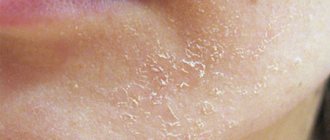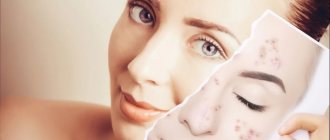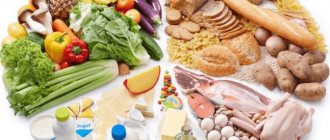Skin care
Everyone knows that the skin of a pregnant woman’s face sometimes seems to glow from within. This is due to the fact that due to hormonal changes, more blood flows to the face and it looks refreshed. However, pregnant women also experience skin problems.
Age spots are a very common occurrence during this period. They can appear on the face, stomach and chest. As a rule, they go away within 4–5 months after the birth of the child.
However, to reduce their expression on the face, dermatologists strongly recommend using sunscreen with SPF of at least 30, and also not neglecting foundation - this will make you feel attractive and confident. By the way, BB and CC creams successfully combine the functions of moisturizing, sun protection and skin toning.
Acne - peeling and rashes on the skin of pregnant women - is associated with changes in the hormonal balance in the body. Skin may become drier, more sensitive and more prone to irritation. Don't worry, this is temporary.
- Use sun protection.
- Choose a new moisturizer for sensitive skin.
- Cleanse your skin with soft facial foams.
- Use anti-acne products, but first make sure that they do not contain substances that are not recommended for pregnant women.
What cosmetics are harmful for pregnant women?
Decorative cosmetics, as a rule, do not contain ingredients harmful to pregnant women. On the contrary, experimenting with makeup is a wonderful opportunity for pregnant women to take care of themselves and be positive.
With “care” products everything is different. Dermatologists recommend that during pregnancy you be attentive to what ingredients are in the creams, tonics and other cosmetics that a woman applies to her skin. The fact is that many substances can penetrate the skin and enter the bloodstream, which can potentially harm the child.
Here is a list of ingredients that are considered unsafe for pregnant women.
- Retinoids. They are usually added to anti-aging cosmetics. These are vitamins of group A, which accelerate the renewal of skin cells and prevent the breakdown of collagen, but they can harm the unborn baby if taken orally. Although there is no official data on the dangers of retinoids when used externally, doctors still recommend refraining from using cosmetics with this ingredient while expecting a child.
- Salicylic acid and BHA, one of its forms. It is used in a large number of cosmetics and is intended to treat acne. It also harms the unborn baby, primarily when taken orally. Doctors do not object to the external use of salicylic acid in creams or tonics - if its concentration does not exceed 2%. But if this additive is in scrubs and peels, salicylic acid penetrates deeper into the skin, and this is already considered unsafe for the baby.
- Soy. Products made from it are useful for pregnant women when added to the diet. How is soy harmful when used externally? Cosmetics based on this ingredient make age spots darker thanks to the phytoestrogens contained in soy. By the way, bergamot oil has the same effect.
Getting rid of acne during pregnancy?
- First of all, in the morning and evening, cleanse your skin using a special gel or foam for washing.
- A good helper is white, blue or green clay, masks from which should be made every 3-4 days. Clay perfectly absorbs sebum and draws out all impurities from the pores, and in addition, has an antibacterial effect. Dilute a small amount of clay purchased at a pharmacy with warm water to a paste and apply to the face for 20 minutes. Remove the mask with a damp cotton swab or pad and wipe your face with salicylic acid lotion.
- Fermented milk products will also help in the fight against rashes, preventing the spread of harmful microbes and soothing the skin. Try applying kefir or whey to your face for several days after each wash. 5 minutes is enough, after which moisturize the skin with your usual cream. Just remember, kefir must be natural, without any fruit additives or preservatives.
- For problem skin, a variety of yeast masks are also good. Yeast can be mixed with milk, mint infusion, or chamomile decoction. Mix the selected ingredients to obtain a homogeneous mass and apply the mask to your face. The mixture should be approximately body temperature. In 15-20 minutes the yeast will harden, so you can simply remove it from the skin with your hands (then you should still wash your face). Repeat the procedure once a week for several months, and the result will certainly not disappoint you.
- Finally, another recipe for a mask for problem skin: take half a glass of long grain rice, pour a glass of warm boiled water, cover and leave for 2 hours. After this time, drain the water, add 100 g of white cabbage, previously pureed, and mix thoroughly. This mask should be applied to the face in a thick layer and left for 15-20 minutes. The composition is washed off with cool water, after the procedure, as usual, the skin is lubricated with a moisturizer.
How to deal with stretch marks
Is it possible to prevent stretch marks during pregnancy? Dermatologists say that genetic predisposition plays a key role here, and about half of women observe the appearance of stretch marks while expecting a child - on the stomach, chest, buttocks and thighs. Even special creams against the appearance of stretch marks will not protect against them. If women in your family have them on the skin, then you are not immune from their appearance. Here are the factors that can increase the likelihood of stretch marks:
- multiple pregnancy;
- rapid weight gain;
- you are carrying a large baby;
- you have excess amniotic fluid.
Dermatologists still recommend preventive measures:
- taking a contrast shower with simultaneous massage with a hard washcloth, you can use scrubs;
- daily moisturizing of the skin with vegetable oil, milk or body cream.
You can also smear the oil on the expectant mother’s tummy, but no one can guarantee that there will be no stretch marks. Don’t get hung up on this: if they appear, their manifestations can be reduced.
Dry facial skin during pregnancy
Many expectant mothers notice that their skin becomes drier during pregnancy. Those who previously struggled with oily shine and enlarged pores now can’t stop looking at themselves. And for those with normal and dry skin, difficult times come: their faces flake, are prone to redness, and the skin is easily injured and inflamed. What to do in this case?
- Observe the skin's reaction to cosmetic products - perhaps this is the problem.
- Drink more plain water if possible.
- Wash your face with mineral water.
- Use moisturizers and choose hypoallergenic cosmetics. Apply moisturizer immediately after washing your face, while your skin is still wet.
- In cold and windy weather, do not apply cream immediately before going outside.
- Try using natural unrefined flaxseed oil, grape seed oil or almond oil instead of night cream. Keep it on your face for about 20 minutes, then wash off with warm water.
- Make sure you include foods rich in polyunsaturated fatty acids in your menu. These are fatty fish, eggs, nuts and seeds, vegetable oils.
- Take steps to humidify the air in your home.
- Take more walks in the fresh air.
Body care during pregnancy
The skin of expectant mothers also suffers from dryness. This phenomenon is especially pronounced in the cold season and during the period of active growth of the baby. Around the middle of pregnancy, many mothers complain that their skin feels “tight” and itches terribly. And if the back and chest cause relatively little discomfort, then the stomach itches is sometimes simply unbearable. Why this happens, even doctors cannot give a definite answer. But the fact that moisturizing and nourishing the skin of the tummy brings relief is confirmed by experience.
It is also necessary to take care of your body skin to prevent the appearance of stretch marks (stretch marks) on the abdomen, chest and thighs. Generally speaking, their presence depends on many factors, including sudden weight gain and genetic predisposition. But it is possible and necessary to minimize unnecessary “striations” through preventive measures.
- If possible, wear cotton underwear and clothing.
- Moisturize your skin with creams daily.
- Use natural unrefined oils as nutrients - olive or cocoa butter. The second is recommended during the cold season, as it prevents chapping of the skin.
- Try to spend as little time as possible in the shower and in a warm bath unless you have a water filter installed in your home.
- Lead an active lifestyle and eat less easily digestible carbohydrates, more protein and vegetables.
Nails and hair during pregnancy
Great news: while expecting a baby, the expectant mother's nails become stronger, and her hair becomes shiny and thicker. Surprises are also possible: wavy hair can become straight, or vice versa.
- •\tIt is worth keeping in mind that the hair seems thick not because more hair has begun to grow, but because it is now falling out less. In normal life, on average, we lose about 100 hairs per day, and during pregnancy, the process of hair loss slows down significantly. After childbirth, the hair will return to its normal state.
- Many women are concerned about excess hair growth on the face and body - do not worry, this is temporary. Choose a hair removal method that is convenient for you. However, remember that depilatory creams are not considered completely safe for pregnant women.
- Also, you should not start using a home epilator if you have not had such experience before: as a rule, the number of ingrown hairs increases during pregnancy, and it is extremely difficult to deal with them, so it is better not to increase the likelihood of their occurrence.
Is it possible to dye your hair during pregnancy?
There is no scientific evidence confirming the dangers of using conventional paint with ammonia during pregnancy. However, it is recommended to temporarily switch to more gentle, possibly unstable, paints or coloring instead of classic coloring.
- During this period, you need to especially strictly follow the instructions for hair dyes - check them for allergenicity by applying a little dye to the skin and waiting the right time. Do not under any circumstances try to dye your eyebrows or eyelashes with hair dye: this is very dangerous and can lead to irreparable consequences, including blindness.
It is worth remembering that during this period it is not recommended to experiment with perm: firstly, the substances included in the special mixture may be unsafe for the child, and secondly, the hair does not behave as usual. The result may be unpredictable.
Acne during pregnancy
They say the face is the mirror of health. Indeed, it is not so easy to hide revolutionary hormonal changes from others when they are reflected on the face in the form of rashes. Although most often the condition of the facial skin of expectant mothers improves and acne goes away, the opposite situation also happens when acne appears from the first weeks. Fortunately, this trouble usually goes away by mid-pregnancy. But this does not mean that the skin does not need help in getting rid of uninvited guests. Moreover, the problem can worsen and become chronic if treated incorrectly.
- Don’t forget to wash your face twice a day with boiled water at room temperature, use delicate cleansers with a neutral ph.
- It is not advisable to use a scrub; it is better to use soft exfoliants - gommages or clay masks, but not more than once a week.
- Do not squeeze pimples under any circumstances, and in general, touch your face with your hands as little as possible.
- Use creams that do not contain paraffin, lanolin, or fatty substances, including oils.
- Do not use caustic drying products; they are suitable for treating teenage acne, but in your case they will only make your skin more vulnerable.
- Use any medications to combat acne only after consulting a doctor! Some of them are contraindicated during pregnancy, as they have a teratogenic (that is, causing disturbances in fetal development) effect.
Breast care during pregnancy
As a rule, everyone is ready for the fact that during pregnancy the breasts become larger - on average by 1 - 2 sizes. Her weight increases, and the ligaments cannot cope with the increased load. After breastfeeding is completed, it may become larger or smaller, everything is individual.
But if its size cannot be influenced, then is it possible to prevent the change in shape? Also, many women note that during pregnancy and childbirth, the nipples become larger and darker. Breast sensitivity may change during this period. What to expect?
1. As for the nipples, their size may decrease after breastfeeding ends, they may become lighter, but in each case everything is individual. The sensitivity of the nipples, as a rule, returns to the state it was before pregnancy.
2. Experts say that it is impossible to prevent changes in breast shape. This is a natural phenomenon. Here are some remedies you can resort to to make your breasts firmer:
2.1.1. after consulting with a specialist, do planks and other special exercises - they affect the pectoral muscles, and not the breast tissue, but nevertheless they can have an effect;
2.1.2. breast massage combined with almond, coconut or olive oil will improve skin tone. You need to be careful not to massage the nipple area, so as not to stimulate the production of oxytocin, which can cause uterine tone. It is recommended to do it about three times a week;
2.1.3. good posture, which can be achieved through yoga and gymnastics - as a result, the shape of the breasts improves;
2.1.4. It is recommended to wear special underwear, first of all, for comfort - during pregnancy, the breasts increase in size and need additional support.
Home treatments
Cleansing.
Cleanse oily skin in the morning and evening with special products for oily skin, preferably with bactericidal additives. It can be milk, gel, foam. The product is applied in a thin layer, after which the skin is massaged with your fingertips for 2-3 minutes, and then washed off with cool water using sponges or cotton balls.
It is very important that formulations for cleansing oily skin do not contain substances that cause the appearance of comedones (blackheads). It is advisable that cosmetic products indicate that they are non-comedogenic. It is also necessary to remember that if you have oily skin, you should not wash your face with soap and hot water, as this can provoke increased activity of the sebaceous glands.
Toning.
After cleansing, wipe the skin with tonic or lotion for oily skin. Its task is to normalize skin acidity and the function of the sebaceous glands, narrow pores and prevent inflammatory processes. Typically, in addition to herbal extracts (chamomile, calendula, plantain, coltsfoot, sage), tonics for oily skin contain bactericidal additives, essential oils (tea tree, eucalyptus), camphor, menthol.
Applying cream.
Mandatory condition: cream for oily skin should not be greasy. It should contain anti-inflammatory substances (chamomile, calendula, sage, plantain, etc.): this prevents the occurrence of inflammatory processes.
Deep cleansing.
It is carried out 1-2 times a week. For these purposes, use: scrubs/peelings with solid particles (if there are no inflammatory processes); gommages/peelings that “roll off” from the face; low concentration fruit acids for home use.
Steam baths have a beneficial effect on the vascular system of the face, increasing blood circulation and sweating. The skin is cleansed of dust, dead cells, secretions of the sebaceous and sweat glands. This procedure is especially useful for rough, oily skin with acne. However, if you have a tendency to dilate blood vessels, steam baths are contraindicated. They are also not recommended for severe heart disease, bronchial asthma, and circulatory disorders.
The duration of steam baths for oily skin is 8-10 minutes. This facial cleansing can be done once every two weeks. To make a steam bath at home, you need a metal container with water (pan or basin) and a terry towel. The water temperature for the steam bath should be approximately 60 °C. The face is cleaned, the hair is tied with a scarf. Cover the head and the vessel with hot water with a towel; if it is very hot, they make a small vent in it. For steam baths you can use medicinal herbs: rosemary, sage, chamomile, linden blossom, peppermint, oak bark, birch leaves and others. For one steam bath, take a tablespoon of the mixture.
If steam baths are contraindicated, other deep cleansing methods can be used. To do this, use ground oatmeal, olive oil, honey, orange or apple juice, kefir, lemon, mineral water or chamomile infusion.
Recipe 1.
In one cup, mix oatmeal with butter until thick sour cream, in another - a teaspoon of honey with 2 tablespoons of juice. First, the face is cleansed with lotion for oily skin. Then apply a mixture of oatmeal and oil and rub it with your fingertips along the massage lines for 2-5 minutes. After oatmeal, a mixture of honey and juice is applied to the face - this is done gradually and rubbed in for 5 minutes. Without washing off the mixture, kefir is applied to the face, to which a few drops of lemon juice have been added. After the mask has dried, wash it off with cool water and wipe the skin with mineral water or chamomile infusion.
Recipe 2.
Grind 1 cup of oatmeal in a coffee grinder. Add 1 teaspoon of baking soda to the resulting oatmeal. The mixture can be stored in a glass jar with a lid in the refrigerator for 1 month. This peeling is used 2 times a week. You need to take 1 teaspoon of the mixture, dilute it with warm boiled water to the state of liquid sour cream and treat your face with light circular movements along the massage lines, paying special attention to contaminated areas. Then the mixture is washed off with water.
Mask course
can be 15-20 procedures every other day. After 2-3 months the course can be repeated. Masks for oily skin are designed to normalize the action of the sebaceous glands. They can be anti-inflammatory, sebostatic (normalizing the functioning of the sebaceous glands), and narrowing pores. For oily skin, masks can be purchased ready-made or homemade recipes can be used.
Herbal mask.
Option 1.
Mix 1 tablespoon of dry herbs chamomile, calendula, yarrow.
Option 2.
Take 1 tablespoon each of calendula, nettle and coltsfoot. The mixture is ground in a coffee grinder. A tablespoon of the resulting mixture is poured with 1 cup of boiling water and left for 15-20 minutes. The liquid is drained, and the steamed mass is applied to the face, previously covered with a gauze cloth with a slit for the nose. The mask is kept for 20 minutes, then removed along with the napkin. The face is rinsed with the remaining broth. You can also pour the broth into ice cube trays and freeze. Ice is used to tone the skin.
Mask for narrowing pores.
Beat the egg white until foam forms and, continuing to beat, add a teaspoon of lemon juice in small portions. The resulting foam is applied with a brush layer by layer until the entire mask is applied. When one layer begins to dry, the next layer is applied. The mask is washed off after 20 minutes, first with warm, then with cold water.
Nourishing mask.
A mask made from 2 egg whites, 30 g of honey, 1 teaspoon of almond or peach oil and 2 tablespoons of oatmeal cleanses and improves the water balance of the skin. Raw proteins are mixed with honey and butter until smooth, and then oatmeal is added. The mask is applied for 20 minutes, removed with a warm and then a cool compress.
Determining your skin type
In order to determine your skin type, 2-3 hours after washing, blot different areas of your face with a paper napkin. An oil stain will appear on an area with oily skin.
Toning mask.
Baker's yeast is good at restoring the balance of oily skin (it contains many B vitamins). The yeast is diluted with warm water to the consistency of thick sour cream, add 2-3 drops of 3% hydrogen peroxide. The mask is applied for 15-20 minutes, after which it is washed off with cool water.
How to choose a bra during pregnancy
Doctors believe that there is no urgent need to use specialized underwear for pregnant women. The main thing is that it does not squeeze the chest.
- Breasts grow in the 1st and 2nd trimesters, only reaching the size that will remain during the feeding period by the 3rd.
- You can choose the same bras for pregnant and nursing women and immediately buy bras that need to be partially unfastened for breastfeeding.
- When choosing a bra, it is important to pay attention to the fabric composition: cotton and lycra are preferable. Such underwear stretches when necessary without causing discomfort. The straps should be wide and the cups should cover the entire chest. There is no need to choose bras with underwires: they can move and pinch the duct during breastfeeding.
- From the second trimester, colostrum may be released from the nipples - use special bra inserts.
- How many bras should you buy? As a rule, women during pregnancy and lactation need three special bras.
Bandage during pregnancy
Many mothers feel the desire to wear a bandage: the load on the back and tailbone makes itself felt. However, doctors categorically do not recommend buying bandages and wearing them without good reason. And that's why:
- abdominal muscles do not strengthen and recover more slowly after childbirth;
- in the third trimester, the bandage may prevent the baby from taking the correct position before birth.
Typically, your doctor may recommend wearing a brace if you have severe back pain or multiple pregnancies. In any case, you need to make sure that this “wardrobe element” does not put pressure on your stomach or cause discomfort. As a rule, it is not recommended to sleep in it. In addition, you need to take breaks during the day - here you need to follow your doctor's recommendations.
We wish you a beautiful and comfortable pregnancy!






